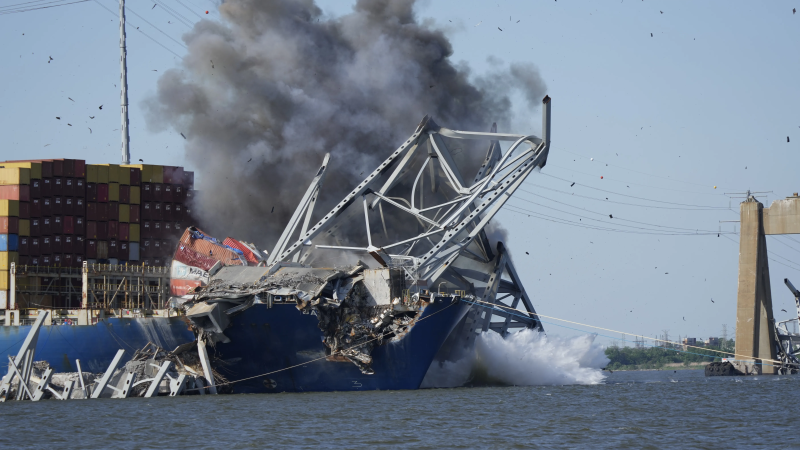Baltimore bridge span demolished with controlled explosives to free cargo ship
Crews in Baltimore "successfully" detonated controlled explosives on Monday to remove a large section of the collapsed Francis Scott Key Bridge from the bow of cargo ship Dali that struck the bridge in March, officials said.
The planned demolition occurred shortly after 5 p.m. Monday after weather conditions, including high winds and lightning, delayed the operation over the weekend. Videos of the demolition showed the small explosives detonating and releasing puffs of smoke into the sky before steel trusses appeared to break apart and fall into the water.
Precision cuts using small charges were made along pieces of the bridge's span that had been lying on top of the Dali's bow since the massive ship lost power and collided with one of the bridge’s support columns on March 26, according to the U.S. Army Corps of Engineers for the Baltimore District. The crash caused the bridge's span to collapse into the Patapsco River, killing six construction workers and disrupting shipping traffic at the Port of Baltimore.
"Thank you to everyone at Unified Command for a flawless, safe execution of these precision cuts and for the care you’ve shown our city during this process," Baltimore Mayor Brandon Scott said on X, formerly Twitter.
The operation marked a major "milestone" in efforts to clear the Port of Baltimore's 700-foot-wide, 50-foot-deep Fort McHenry Channel, Scott added. The demolition will allow crews to re-float the Dali and free it from the channel, which will help restore maritime traffic through the critical port.
In 2023, the port ranked first in the nation in several cargo categories, including autos and light trucks, farm and construction machinery, imported sugar, and imported gypsum, according to the state of Maryland. Prior to the collapse, between $100 million and $200 million of cargo passed through the port every day, USA TODAY previously reported.
U.S. Transportation Secretary Pete Buttigieg warned in March that the collapse would cause devastating economic impacts, costing about $2 million in wages a day and 8,000 jobs.
How many ships hit bridges, lose power?Data shows jarring numbers on the rise.
Officials hope to move container ship Dali within two days
During a news conference Monday, U.S. Army Corps of Engineers Col. Estee Pinchasin said the precision cuts were the "safest and most efficient" method to break down the steel span — which was estimated to be about 500 feet long and weigh about 600 tons.
Small, linear charges were placed inside cuts made along the bridge's truss to create pressure, separate the metal and cut through the steel, Pinchasin said. The controlled detonations were meant to break the truss into small sections and enable crews to use cranes and barges to remove the wreckage, according to the U.S. Army Corps of Engineers.
"After we do the precision cutting, we will then go back and resurvey the channel as well as survey around the Dali to make sure there are no obstructions that come from that precision cutting that would interfere with traffic," U.S. Coast Guard Rear Adm. Shannon Gilreath said at the news conference. "Then we will reopen the limited-access channel to traffic at that particular time."
Officials hope to re-float the Dali and remove it in about two days, Gilreath added.
The 21 crew members of the Dali, who have been on board the ship since the collapse, were safely sheltered during the controlled demolition, CNN reported. The crew has been maintaining the ship and "performing their normal crew duties," Darrel Wilson, a spokesperson for Synergy Marine Group, which manages the Dali, told CNN.
The U.S. Army Corps of Engineers and Synergy Marine Group did not immediately respond to USA TODAY's requests for comment Monday.

Salvage crews work to deepen Fort McHenry Channel
Salvage crews have been working for weeks to clear debris from the Fort McHenry Channel, according to Gilreath.
"They have now deepened that channel to 48 feet in depth and it's now 350 feet wide," Gilreath said. "They will continue to work on that channel after we are able to do the precision cutting (Monday) on the Dali."
Since the collapse, four temporary alternate channels have been opened to allow for some shipping to resume. Gilreath said that authorities have moved 365 commercial vessels through the temporary channels over the last seven weeks.
Officials reopened the Fort McHenry Channel with limited access for shipping traffic last week, Gilreath added. In April, the U.S. Army Corps of Engineers announced an "ambitious" timeline to fully reopen the channel by the end of May.
Gilreath confirmed Monday that authorities were "on track to fully reopen the (channel) to 50 feet (deep) and 700 feet wide by the end of the month."
Aftermath of Baltimore Key Bridge collapse
Eight construction workers were fixing potholes on the bridge when the Dali struck it, causing it to collapse into the Patapsco River. Rescuers pulled out two workers, but six were presumed dead after an hourslong search.
Recovery operations for the victims concluded last week after the sixth body was found in the Patapsco River, the Baltimore County Police Department said.
The National Transportation Safety Board and the FBI have opened investigations into the bridge collapse. Safety investigators have recovered the ship's "black box" recorder, which provides data on its position, speed, heading, radar, and bridge audio and radio communications, as well as alarms.
State officials have also estimated that it will cost about $1.7 billion to $1.9 billion to rebuild the bridge and wouldn't be completed until fall 2028.
Contributing: Reuters
Disclaimer: The copyright of this article belongs to the original author. Reposting this article is solely for the purpose of information dissemination and does not constitute any investment advice. If there is any infringement, please contact us immediately. We will make corrections or deletions as necessary. Thank you.







